Scoop Audio: Anderton Bottom Trawling Press Conf. & Followup Questions
How Big Is The Deep Sea Coral Smashing Industry? Nobody Really Knows
Audio and images Alastair Thompson
Images of bottom trawling bycatch (c) Ministry of Fisheries
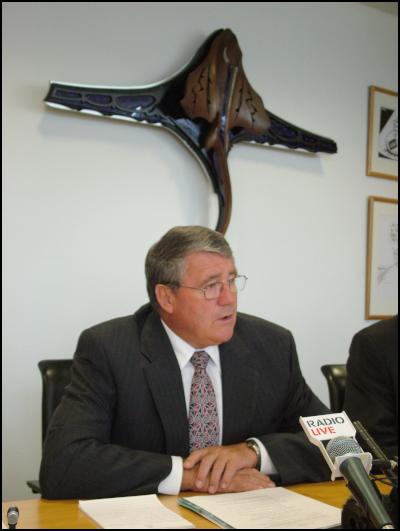
Fisheries Minister Jim Anderton
Fisheries Minister Jim Anderton held a press conference today with the fishing industry to "welcome" a proposal from the Deepwater Stakeholder Group for the placement of a large section of New Zealands EEZ out-of-bounds to bottom trawling.
Listen to the
full press conference audio:
Stream:
http://img.scoop.co.nz/media/audio/0602/AndertonSeaficPresser.m3u
Download:
http://img.scoop.co.nz/media/audio/0602/AndertonSeaficPresser.mp3
Opponents of bottom-trawling – notable among them Greenpeace – say the relatively new practice of using nets with giant rollers and scrapers on sea-mounts, is destroying centuries and possibly millennia old deep sea habitat and that it will have unknowable effects on the marine eco-system.
Mr Anderton warmly welcomed the seafood industry's proposal suggesting it was world leading, and congratulated the industry on making it.
In response to questioning from Scoop he saw no mixed signal inherent in the the Govt. welcoming this proposal for New Zealand's EEZ and simultaneously supporting an interim moratorium on high seas bottom-trawling in advance of the formation of a Regional Fisheries Management Organisation (RMFO) for the bulk of the South Pacific.
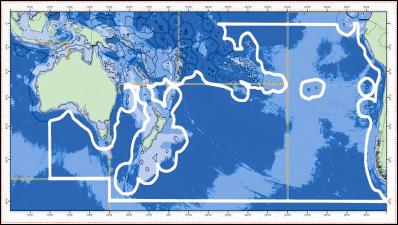
Map showing the boundaries of the proposed RMFO area.
Click for big version
Mr Anderton's press conference became a little testy at times as Mr Anderton confused Scoop's co-editor with someone he had met – and obviously found disagreeable – earlier in the day at Te Papa where the RMFO regional conference on fisheries is being held.
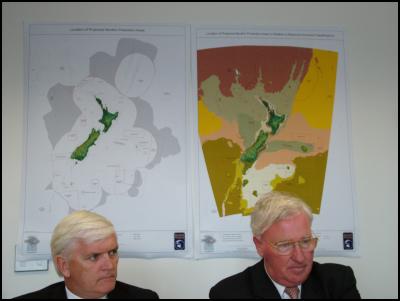
Click for big version
Two members of the Deepwater Stakeholder Group with maps of NZ's territorial waters showing the proposed areas for conservation.
For the avoidance of confusion the seafood industry proposal is not yet being officially endorsed by the Government. While Mr Anderton made no bones during the press conference about being a "cheerleader" for primary industries in general and fisheries in particular, the Deepwater Stakeholder Group's proposal is at this stage purely an industry proposal which is being "welcomed" by the Minister and Ministry of Fisheries. It will now go to full consultation before formal consideration by the Government.
Listen to the full
press conference audio:
Stream:
http://img.scoop.co.nz/media/audio/0602/AndertonSeaficPresser.m3u
Download:
http://img.scoop.co.nz/media/audio/0602/AndertonSeaficPresser.mp3
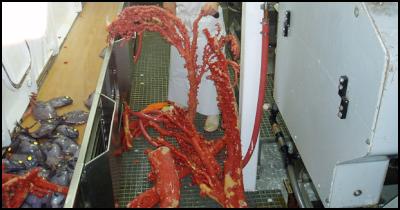
Ancient Coral Tree
Click for big version
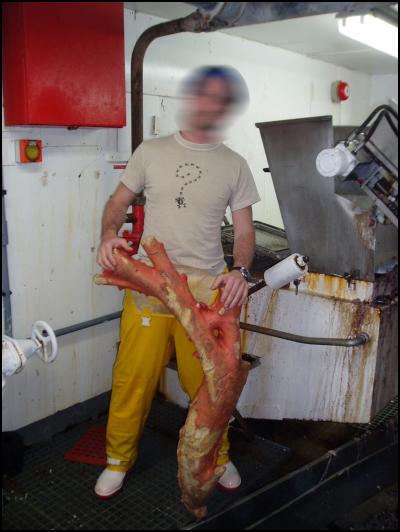
Fisherman with deep sea coral tree stump
Click for big version
Towards the end of the press conference Scoop attempted to discover how big an industry the bottom trawling industry really is.
An industry representative replied that the information is contained in the information pack that came out with the proposal.
Scoop also asked how long bottom trawling had been around, to which the industry representative replied that his company had been doing it for 100 years.
Unfortunately both these answers are misleading and so Scoop decided to inquire a little further after the press conference.
The information pack distributed with the proposal states that "deepwater and middle depth fisheries" provide seafood source worth $800 to $1200 million FOB annually.
However this figure is close to three quarters of the returns from the entire fishing industry and does not really describe the size of the fishery which involves the use of destructive bottom trawling machinery which is what produced the controversy that has led to the current proposal.
Speaking on the phone Eric Baratt, managing director of Sandford Limited and spokesman for the Seafood Industry Council, told Scoop that the $1 billion of fisheries described in their presentation includes the hoki, ling and orange-roughy fisheries all of which are bottom dwellers.
Most of this fishery, Mr Baratt eventually conceded, involves bottom trawling which disturbs sandy and muddy sea bottoms, most of it does not involve the use of heavy gear complained about by Greenpeace and most does not involve smashing coral forests.
So what then is the value of the fishery that does involve the flattening of coral forests?
It seems that the answer to this question is impossible to arrive at via Mr Baratt.
Mr Baratt did agree that the kind of destructive coral smashing fishing that has recently become controversial – and greatly upset Greenpeace - has not been going on for 100 years but is in fact a relatively recent technological development perhaps 25-30 years old.
Mr Baratt would not however say which fish were being targeted when the coral smashing gear was used on sea mounts but agreed some of the "unusual" deep sea fish obtained in this way was used in the production of low value fish meal – i.e. fish feed fed to salmon and other farmed fish.
In the end, Mr Baratt said that the heavy set coral smashing equipment was actually used very seldom in commercial fishing generally.
In which case, Scoop asked, why was the fishing industry not happy to give up its use altogether?
Mr Baratt emphasized that the fishing industry wanted to be able to, "continue to fish in those areas that had been fished the year before". He also commented that nobody suggested that the Canterbury Plains be made to revert back to forest.
What this seemed to imply was that the coral smashing gear was no longer needed for some of the bottom trawling undertaken by the New Zealand fishing industry precisely because the coral forests had already been smashed? Mr Baratt refused to comment on this speculation however.
Scoop then asked Mr Baratt whether the Seafood Industry Council had received any legal advice over whether the smashing of coral forests and ongoing exploitation of the cleared areas was consistent with Fisheries Act provisions that require "any adverse effects on the aquatic environment as a whole… be avoided, mitigated or remedied".
"I am not going to make any comment on legal advice that has or hasn't been received by the industry," Mr Baratt replied.
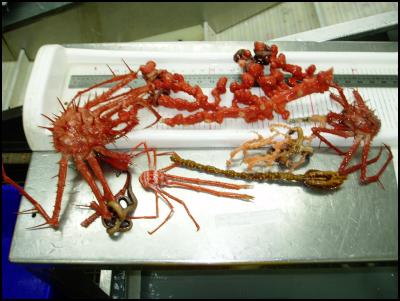
Assorted By Catch
Click for big version
An official in the office of the Minister of Fisheries advised Scoop subsequently that Resource Management law tended to indicate that adverse effects on the environment did not need to be avoided absolutely, but just reasonably mitigated.
The official said he had heard anecdotally – from Greenpeace - about the clearing of paths through coral to create zones to safely catch fish – however he had no official knowledge of whether this occurred. That said evidence from fisheries monitors suggested that the by-catch of coral was an occasional rather than a routine phenomena when fishing for quota fish over the tops of sea-mounts..
Contrary to what many believed, orange roughy – a valuable species which is caught on sea-mounts - does not live inside the coral forests, but above them. The official said his understanding was that the fishers attempted to fish as close to the coral as they could without touching it, and that the forest crushing heavy gear was mainly defensive.
As for the size of the industry involved in the destructive kind of bottom trawling that Greenpeace is concerned with, he said he would ask the Ministry to provide some figures as he did not know off-hand.
For Further Background:
- NZ Govt. Releases - NZ calls for urgent action on bottom trawling & World's largest EEZ marine conservation proposal
- Seafood Industry Council - Massive Closures to Protect Bio-diversity Proposed & Full Details Of The Proposal, Powerpoint presentation
- Scoop Archives - Google Scoop For Background Info On Bottom Trawling & Scoop Fisheries Archive Index
- Greenpeace - Blog on the International fisheries meeting underway in Wellington this week & Take Action Page
ENDS



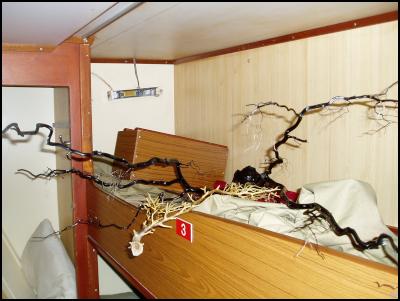
 Jim Mikoz: Look Out Rocks … Oops Too Late
Jim Mikoz: Look Out Rocks … Oops Too Late Peter Dunne: Dunne’s Weekly - National And Labour Combine To Shut Out Greens
Peter Dunne: Dunne’s Weekly - National And Labour Combine To Shut Out Greens Ramzy Baroud: Voting Against Genocide - How Gaza Defeated The Democratic Establishment
Ramzy Baroud: Voting Against Genocide - How Gaza Defeated The Democratic Establishment  Alastair Thompson: Google's Support For Democracy And Media In NZ | Part 2
Alastair Thompson: Google's Support For Democracy And Media In NZ | Part 2 Eugene Doyle: BBC Goes Full Goebbels In Support Of Israeli Soccer Hooligans
Eugene Doyle: BBC Goes Full Goebbels In Support Of Israeli Soccer Hooligans Binoy Kampmark: They Were There First - Election Denialism, The Democratic Way
Binoy Kampmark: They Were There First - Election Denialism, The Democratic Way